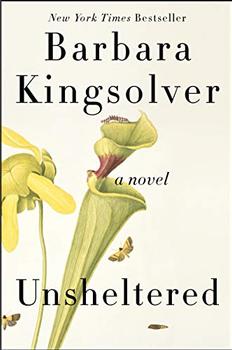Reading Guide Questions

Please be aware that this discussion guide will contain spoilers!
- What do the living spaces in their various conditions throughout the novel suggest about the people living in them? Figuratively speaking, which foundations turn out to be solid, or precarious?
- Mary Treat tells Thatcher that to be unsheltered is to live in daylight. What does she mean? What kinds of shelter do these characters crave, in their different centuries? How might sheltered lives—or the craving for them—become a hindrance?
- Which of the many challenges confronting Willa are hers alone to bear, and why? What do you see as the foundation of her successful relationship with Iano? How has marriage changed, or not changed, since the time of Rose and Thatcher?
- Why do you think happy marriages so rarely appear in fiction?
- In what ways, if any, do you find Nick's bigotry and anger comprehensible? What accounts for Tig's patience with him, despite their differences? How do the family's conflicts relate to the polarization of present times? What's suggested by Willa's and Nick's argument taking place on the Walt Whitman Bridge?
- How are Mary Treat's eccentricities related to her strengths? In what ways is her friendship especially valuable to Thatcher? What is the role of the scientist in times of social upheaval?
- What are some of the "old mythologies" discussed by Mary and Thatcher, to which people cling for comfort even when they're no longer true? Are any of these still popular in the modern era?
- Mary tells Thatcher she is "astonished at how little most people can manage to see." Specifically, which realities in her century, and ours, do people find it difficult to see? What are the costs? Is it possible to view ourselves objectively in our own time?
- When Thatcher sees the world "divided in two camps, the investigators and the sweeteners," what is he observing? Which of the novel's characters are the former, and which are the latter? Where would you place yourself?
- Consider the creative names and botanical character identities throughout the novel. What do they reveal? How have the various characters' education or backgrounds shaped their perspectives? Why do you think a select few of them are able to think outside of what Tig calls "the cardboard box," or Mary, "the pumpkin shell?"
- What family dynamics might have made Tig and Zeke so different and combative, while Jorge and his siblings are close and supportive?
- How do the characters in two centuries variously understand and connect with the natural world? When Willa's phone causes "thousands of birds [to burst] from their tree skyward like a house going up in smoke," what does this potent image suggest? What about the ants that seem to inhabit the neighborhood outside the boundaries of time?
- When Willa complains that "the rules don't apply anymore," what does she mean? How are Zeke and Tig preparing differently for a future in which they will have less than their parents? Did the novel move you to any new insights about generational difference?
- How does the powerful experience of loss affect this novel's characters, at personal and societal levels? Is the nature of grief constant across human experience? How might "the loss of what they know" influence people's political behavior?
- The novel's epigraph quotes a Wallace Stevens poem, "The Well Dressed Man with a Beard." How does the epigraph relate to the novel, and how might Christopher Hawk (a well-dressed man with a beard) serve as its pivot point? Why do you think the author chose to set the story in two different centuries? And why these two in particular?
- In shifting between chapters, what changes did you notice in the characters' language, or the narrative tone? In what ways did you find the two separate narratives connected?
- What is the "precise balance of terror and mollycoddling" that Charles Landis manages? How, when, and why do you think people respond to this leadership style?
- The shooting of Uri Carruth by Charles Landis, and subsequent not-guilty verdict, are actual historical events. Is the anecdote relevant to the present? What is the role of journalism in a healthy society? Who is responsible for its integrity?
- As they shift from parent-child to a more adult relationship, what does Willa learn from her daughter? How might "the secret of happiness" be "low expectations?" How does this relate to the lost-and-found quote about happiness from Willa Cather's My Àntonia?
- Thatcher settles finally on seeing Mary Treat as "a giant redwood: oldest and youngest of all living things, the tree that stood past one eon into the next." Do you agree?
Unless otherwise stated, this discussion guide is reprinted with the permission of Harper Perennial.
Any page references refer to a USA edition of the book, usually the trade paperback version, and may vary in other editions.

 Book Reviewed by:
Book Reviewed by:





